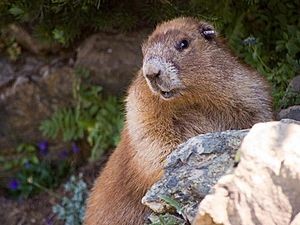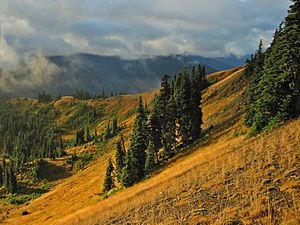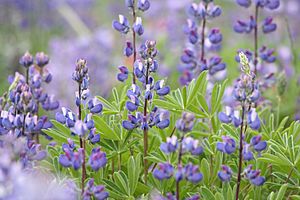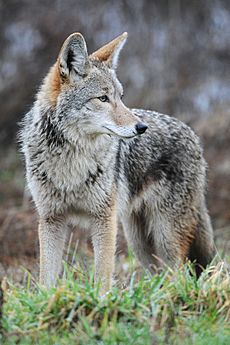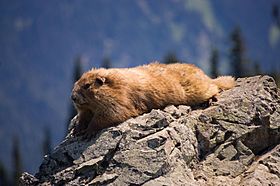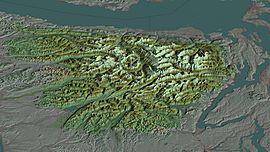Olympic marmot facts for kids
Quick facts for kids Olympic marmot |
|
|---|---|
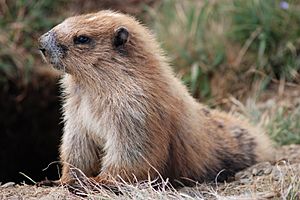 |
|
| Conservation status | |
| Scientific classification | |
| Genus: |
Marmota
|
| Species: |
olympus
|
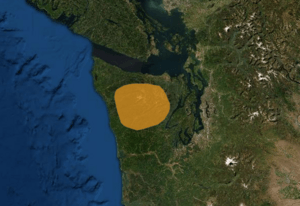 |
|
| Range | |
| Synonyms | |
|
Arctomys olympus Merriam, 1898 |
|
The Olympic marmot (Marmota olympus) is a type of rodent that belongs to the squirrel family. You can only find it in the state of Washington, in the middle parts of the Olympic Peninsula mountains. This marmot's closest relatives are the hoary marmot and the Vancouver Island marmot. In 2009, the Olympic marmot became the official endemic mammal of Washington. This means it's a mammal found only in that state.
This marmot is about the size of a house cat. It usually weighs around 8 kg (18 lb) in the summer. Male marmots are often bigger than females, weighing about 23% more. You can spot an Olympic marmot by its wide head, small eyes and ears, short legs, and a long, bushy tail. Its sharp, rounded claws help it dig burrows, which are like underground homes. Its fur color changes with the seasons and as it gets older. Most of the year, an adult marmot's fur is brown with some smaller white areas.
Olympic marmots mostly eat different kinds of plants found in meadows, including dry grasses. They also use these grasses to make soft beds in their burrows. Many animals hunt them, like land mammals and birds of prey. Today, their main hunter is the coyote. The Olympic marmot is listed as a species of least concern on the IUCN Red List. This means it's not currently in danger of disappearing. It is protected by law in the Olympic National Park, where most of them live.
These marmots live in groups called colonies, which build burrows in different mountain spots. A colony can be small, with just one marmot family, or large, with many families and up to 40 marmots. Olympic marmots are very social animals. They often play fight and use four different whistles to talk to each other. They go into a deep sleep called hibernation in September and don't eat during this time. This causes them to lose half their body weight! Adult marmots wake up in May, and their young wake up in June. Female marmots can start having babies when they are three years old. They usually have one to six young every other year.
Contents
Taxonomy
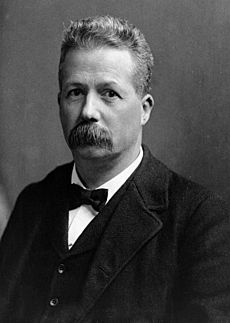
An American zoologist (animal scientist) named Clinton Hart Merriam was the first to officially describe the Olympic marmot in 1898. He called it Arctomys olympus. The name Arctomys comes from Greek words meaning "bear-mouse." The species name, olympus, was given because this marmot lives in the Olympic Peninsula.
Today, the Olympic marmot is grouped with all other marmots in the genus Marmota. Scientists believe the Olympic marmot might have come from an isolated group of hoary marmots during the last ice age.
Description
The Olympic marmot has a wide head with small eyes and ears. Its body is strong and stocky, with short legs and sharp, rounded claws that help it dig. Its tail is bushy and can be from 18 to 24 cm (7 to 9 in) long.
An Olympic marmot is about the size of a house cat. Adults usually weigh between 2.7 and 11 kg (6 to 24 lb) and are about 67 to 75 cm (26 to 30 in) long. Male marmots are generally heavier than females. The Olympic marmot is the largest of the six marmot species found in North America.
Their fur has two layers: a soft, thick underfur for warmth and coarser outer hairs. Baby marmots have dark gray fur. As they get older, their fur turns grayish-brown with lighter patches. Adult marmots are mostly brown with some white or pale brown spots for most of the year. Their fur gets darker as the year goes on. The fur around their muzzle (nose and mouth area) is almost always white, with a white band in front of their eyes.
You can tell an Olympic marmot apart from a hoary marmot because the Olympic marmot does not have black feet or a black spot on its head. The Vancouver Island marmot has a similar chocolate brown fur color with white patches.
Distribution and habitat
Olympic marmots live naturally in the Olympic Mountains in Washington state. About 90% of their homes are inside Olympic National Park. You can often see them there, especially on Hurricane Ridge. However, in some areas of the park, their numbers are going down. This is partly because trees are growing into their meadow homes and partly because of coyotes hunting them. They are rarely seen in the wetter southwestern part of the park.
Inside the park, Olympic marmots live in green sub-alpine and alpine meadows, fields, and rocky mountain slopes. They live in colonies with burrows (underground homes) spread out in different mountain spots. Some meadows might have only one marmot family, while others can have many families, adding up to 40 marmots.
Their burrows can be found at heights from 920 m (3,020 ft) to 1,990 m (6,530 ft). They are most often found between 1,500 m (4,900 ft) and 1,750 m (5,740 ft). Burrows are more common on south-facing slopes. These slopes usually get more rain and snow, about 75 cm (30 in) per year, which means more plants for them to eat. A marmot family's home area usually covers about 0.2 to 2 hectares (half an acre to five acres). The Olympic marmot is well-suited to its cold home, where snow can fall almost every month.
Ecology
Feeding
Olympic marmots eat plants found in meadows. These include avalanche and glacier lilies, heather blossoms, subalpine lupine, mountain buckwheat, harebells, sedges, and mosses. They prefer green, soft, flowering plants. But in early spring, when other plants haven't grown yet, roots are a big part of their diet. In May and June, they might even chew on trees for food. Sometimes, they also eat fruits and insects. They get all the water they need from the juice in the plants they eat and from dew on the leaves.
When snow covers the plants, marmots might eat more meat. They might eat dead animals they find while digging for roots. They could also hunt chipmunks that are still hibernating. During this time, they get water from melted snow. Olympic marmots do not store food in their burrows for hibernation. Instead, they eat a lot and get very fat before they go to sleep. They can even double their body weight to survive eight months without eating.
Predation
The main animals that hunt Olympic marmots are land mammals like coyotes, cougars, and bobcats. However, golden eagles, which are birds of prey, also hunt them. Black bears probably don't hunt marmots very often. Marmots usually don't make alarm calls unless a bear comes within 6 m (20 ft) of their colony. Coyotes are the main hunters. Studies show that marmots make up about 20% of what coyotes eat during the summer.
Like all other marmots, Olympic marmots use a special whistle called a "trill" as an alarm call. This warns other marmots that a hunter is nearby. If the alarm calls keep going, it means the hunter is very close, and the marmots become extra careful. If there's just one alarm call, the marmots will look around to see what's happening. They make more alarm calls for land hunters, especially coyotes, than for birds flying above.
When a marmot gets nervous or bothered by a hunter, it might pull back its top lip to show its upper teeth. This can be like a warning sign for hunters.
Behavior
Colonies
Olympic marmots are social animals that live in groups called colonies. These colonies usually have many burrows. How active they are depends on the weather, time of day, and time of year. In June, July, and August, when there's a lot of rain and fog, marmots spend most of the day inside their burrows. They usually look for food in the morning and evening. Between these times, you might see Olympic marmots lying on rocks to warm up in the sun. They also groom each other, play, chirp, and eat together. Their burrows are used for many things: for hibernation, for protection from bad weather and hunters, and for raising baby marmots.
A typical marmot colony has one male, two to three females, and their young. Sometimes, groups can have more than a dozen animals. Young marmots stay with their family for at least two years. So, a burrow often has both new babies and two-year-old marmots living together. Marmots usually don't move to other colonies. The only exception is young adults, about two to three years old, who might leave to start their own families somewhere else. Females usually move only a few hundred meters, but males often move several kilometers away from where they were born.
A colony might also have a "satellite" male. This male is smaller and younger than the main male of the colony. He might take over as the main male if the current one dies. The satellite male lives in a separate burrow, about 55 to 150 m (180 to 490 ft) away from the rest of the colony.
Communication
When Olympic marmots greet each other, they usually touch noses or nose to cheek. When they are trying to find a mate, they might gently lock teeth and nibble each other's ears and necks. They also like to play fight. In play fighting, two marmots stand on their back legs and push each other with their paws. This play fighting is more rough between older marmots.
They communicate using four different types of whistles. These are flat calls, ascending calls, descending calls, and trills. All these sounds are in a similar high-pitched range. Flat, ascending, and descending calls are usually made one at a time. The ascending call lasts about half a second. It starts with a "yell" on one note and ends with a "chip" on a higher note. This call is often used as a warning for strange smells or noises. You can also hear these "yips" when Olympic marmots are play fighting, along with low growls and teeth chattering. The descending call ends on a lower note than where it started.
The trill sounds like many ascending calls put together into one longer sound. It has many different notes and is used as an alarm call. This tells other marmots that danger might be coming and they should go back to their burrows. Females with young marmots often make the trill call more than other marmots. This is because they are responsible for watching out for their babies and other family members near the burrow. If marmots are not used to seeing people in an area, they might also make a trill call when they see a person, to warn others. But in places like Hurricane Ridge, where they see humans often, most marmots won't react to people at all.
They also communicate using their sense of smell. A special gland in their cheek releases chemicals. They rub these chemicals on things like shrubs and rocks. Other marmots in the area can then smell these marks.
Hibernation
Olympic marmots start to go into hibernation in early September. Before they hibernate, they bring dry grasses into their burrows to use as bedding or even as a little food. Sometimes in early September, marmots will stay in their burrows for a few days in a row. They only come out briefly to find a little food. During this time, they don't play fight or socialize much. They just peek out and sit calmly outside their burrows.
Female marmots who haven't had babies yet and adult males go into hibernation first. This is because they don't need to store as much fat. Females who have had babies, yearlings (one-year-olds), and young of the year go into hibernation a few weeks later. This is because they need to gain more weight. All the marmots in a colony hibernate together in one burrow space. They close off the entrance with dirt. Adult marmots wake up in May, and the young ones wake up in June. Marmots do not eat during hibernation, so they must store a lot of fat before they go to sleep.
These marmots are "deep hibernators." This means they are very hard to wake up. Their body temperature drops to below 4 °C (40 °F), and their heart rate can slow down to just three beats per minute. Marmots warm their bodies up about every ten days. Olympic marmots lose half of their body weight during the seven to eight months of winter hibernation. Hibernation is the most dangerous time for them. In years with little snowfall, as many as 50% of the young marmots born that year might die from the cold. This is because snow acts like a blanket, keeping them warm. When they come out in early May, there is still a lot of snow from the winter. So, they are not very active at this time. Sometimes, they are so confused after waking up that they have to re-learn where things are in their colony. They might wander around until they find their burrows.
Life cycle and reproduction
The Olympic marmot, along with the hoary marmot, has the slowest reproduction rate of any rodent. A female Olympic marmot usually has a litter of one to six young (about 3.3 on average) every other year. In any given year, about one-third of the females will have babies. Half of the baby marmots die before the next spring. Those that survive can live into their teenage years. Both males and females can start having babies when they are three years old. However, females usually don't reproduce until they are four and a half years old.
Marmots come out of hibernation at the beginning of May. About two weeks later, the females go into heat (estrus), which means they are ready to mate. After hibernation ends, both male and female Olympic marmots try to attract each other with special behaviors. Females who have never had babies before tend to be more aggressive. They might chase or start fights with males. Male Olympic marmots often mate with three or four females each mating season.
About four weeks after mating, the female gives birth to her young in a burrow lined with grass underground. Newborn babies cannot see, have no fur, and are pink. At first, you can't tell if the young are male or female just by looking at them. It takes about a month before the young Olympic marmots first leave the burrow. Around the same time, they start to be weaned (stop drinking their mother's milk). Even after they are allowed to come out, the young initially stay very close to the burrow. You can find them chasing each other and playfully wrestling. Within a few weeks of first coming out, the young are fully weaned and can find their own food. Olympic marmots are not completely independent from their mothers until they are two years old. Female marmots who can have babies are very important for marmot populations. If a female of breeding age dies, it can take years to replace her. This is because marmots usually have only up to six babies in a litter, they take a long time to grow up, and many marmots die before they are old enough to have babies.
Interaction with humans
The Olympic marmot is the second-rarest marmot in North America, after the critically endangered Vancouver Island marmot. People first saw marmots in the Olympic Peninsula in the 1880s. In the 1960s, a scientist named David P. Barash studied Olympic marmots for three years. He reported that there were many marmots in the mountains. In 1989, scientists thought there were only about 2,000 Olympic marmots. However, this low number was likely due to not collecting enough information. Not much more research was done until the late 1990s, when people became worried about how many marmots were left.
Park rangers and frequent visitors to the Olympic National Park noticed that some groups of Olympic marmots had disappeared from their usual homes. Because of this, the University of Michigan started a study in 2002. The marmot population kept going down by about 10% each year until 2006. Scientists found that coyotes, which hadn't been in the area before the 1900s, were the main reason female marmots were dying. This stopped the population from growing back. By 2006, the number of marmots had dropped to 1,000. But from 2007 to 2010, the numbers went up to around 4,000. Colonies became stable, and more marmots survived. In 2010, volunteers started collecting information about marmot populations in the park through a special program.
The Olympic marmot has been listed as a species of least concern on the IUCN Red List since 1996. This means it's not currently facing a high risk of extinction. Even though it lives in a small area, 90% of its home is protected because it's inside Olympic National Park. The park is also a UNESCO Biosphere Reserve and a World Heritage Site. Washington state law says that the Olympic marmot is a protected wildlife species and cannot be hunted.
This species can be affected by climate change because they are sensitive to changes in their homes. When meadows in Olympic National Park became too dry, marmots either died or moved away. In the future, forests might take over the meadows. Climate change could also change when, what, and how well the marmots' food grows. Olympic marmots might become easier for hunters to catch if daytime temperatures get too hot for them to look for food. This would make them look for food in the cooler evenings, when hunters are harder to spot. In warm winters, coyotes hunt more marmots. Lower snow levels allow coyotes to go higher up the mountains where marmots live. These are areas they usually can't reach during a normal cold winter. However, climate change could also have some good effects. A warmer climate could mean a longer growing season. This would allow marmots to grow up faster and have babies more often.
In 2009, the Olympic marmot became a state symbol of Washington. It was named the official "endemic mammal." Governor Chris Gregoire signed the bill into law after a two-year effort by fourth and fifth graders from Wedgwood Elementary School in Seattle. The students researched the marmot's habits and answered questions from lawmakers. They helped overcome some initial disagreements about having another state symbol.
See also
 In Spanish: Marmota olímpica para niños
In Spanish: Marmota olímpica para niños



